Menu

Did you know that Gianforte Farm in Central New York has grown organic grains for 18 years? They’ve sold their flour and grains directly to customers since 2010. This brings the freshest baking products from their farm to your table.
Using locally-milled grain from Gianforte Farm brings special challenges and joys to baking. Baking with whole grains means you work with flour that’s not like what’s in the shops. It’s a hands-on experience, where you adjust recipes to the dough’s needs each day. This makes your baking taste, look, and feel its best. And it’s about making healthy, organic baking choices.
Want to learn more and get inspired for baking? “Whole Grain Baking: Delicious Recipes Using Nutritious Whole Grains” by King Arthur Flour is a great pick. It goes well with what Gianforte Farm offers.
Baking with whole grains is more than cooking; it’s about health and helping the planet. Whole grain flour makes your bakes tastier and healthier. It has parts like the bran and germ, packed with nutrients.
Whole grains have huge health benefits. They’re full of fibre, good oils and nutrients. Using white whole wheat flour for half of a recipe can add lots of fibre. And, whole grain flours make recipes’ textures better if left to rest overnight.
Choosing whole grains supports a more sustainable baking culture. It also helps local farmers, like those at Gianforte Farm. These farmers care for the earth in their work. And, using their flour connects us to the roots of our food.
Trying orange juice in recipes can balance whole grains’ flavours. This makes our food both healthy and tasty. Also, kneading whole grain bread softly helps it get lighter. This shows our care for the planet in small ways.
Wholemeal flour is made by grinding the entire grain, including the bran, germ, and endosperm. This means it keeps all the good stuff, making it healthy for cooking. Flours like Bread Flour and Pastry Flour from Gianforte Farm show that different kinds of wheat bring various textures and tastes.
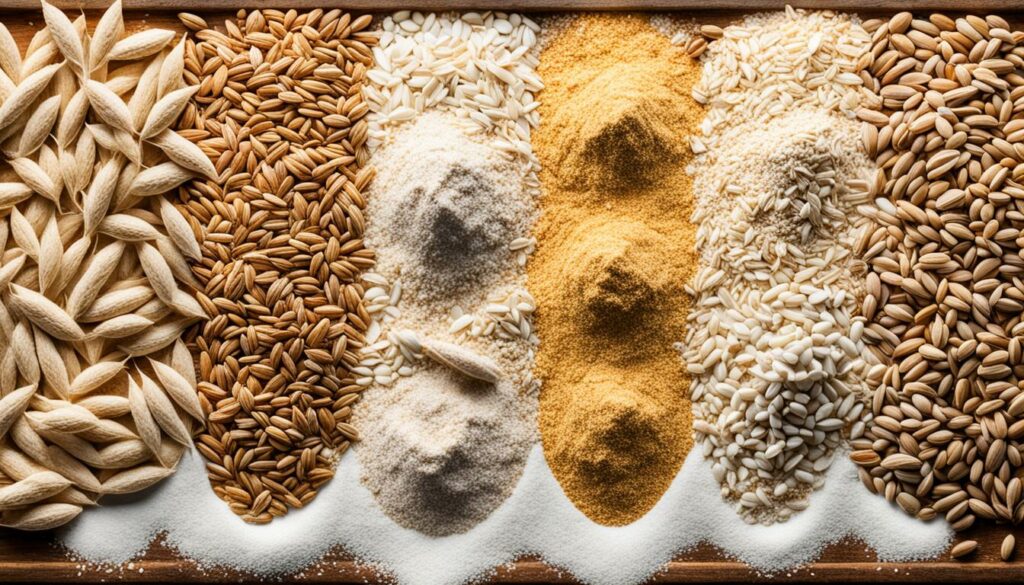
Whole wheat and wholemeal flour come from whole grains, but they bake differently. Whole wheat flour, from hard red wheat, adds a strong taste and dense texture. On the other hand, wholemeal flour, a mix of wheat types, including softer ones, has a lighter look and taste. It can make your baked goods more tender and tasty.
There are many types of whole grain flours to try in your baking. Here’s a look at some:
| Type | Description | Best Use |
|---|---|---|
| Spelt Flour | Ancient wheat strain with a slightly sweet flavour and similar texture to all-purpose flour | Breads, pastries |
| Kamut Flour | Produced from Khorasan wheat, offers a buttery flavour and is lighter than classic whole wheat flour | Breads, cookies |
| Amaranth Flour | Gluten-free with a slightly nutty and sweet flavour | Waffles, pancakes |
| Brown Rice Flour | Gluten-free, fine-grained, and mild flavour | Scones, muffins |
| Buckwheat Flour | Gluten-free, dark, and slightly bitter taste | Chocolaty treats, pancakes |
| Sorghum Flour | Gluten-free with a fine, sweet, neutral taste | Pie crusts, cookies |
Each kind of whole grain flour can make your different recipes even better. Using them needs some tweaks, like the autolyse method. This makes sure the flour soaks up water well before you bake. This way, you’re more likely to get great results.
Starting with whole grain baking is thrilling and fulfilling. It’s key to pick the right whole grain flour and learn to use basic baking tools well. This ensures your treats turn out just right.
Think about your recipe’s needs when selecting flour. For instance, Gianforte Farm’s Bread Flour and Red Fife Flour bring special touches to various bakes. Their protein and consistency impact moisture and how well the dough rises.
Having the right tools is essential for whole grain baking. Here are the basic tools every baker needs:
With these tools, you’re ready to learn the skills of whole grain baking.
| Tool | Importance |
|---|---|
| Kitchen-Aid mixer | Ensures thorough mixing of ingredients |
| Mixing bowls | Available in various sizes for diverse baking tasks |
| Measuring instruments | Precision in measurements is key to baking success |
| Storage containers | Keep the flour fresh and ready for use |
Baking with whole grains is all about how much moisture is in your mix and the protein levels. Getting these right is key to the perfect taste, feel, and look. Let’s go over a few must-know tips for using whole grains in baking to make sure your treats are just right.
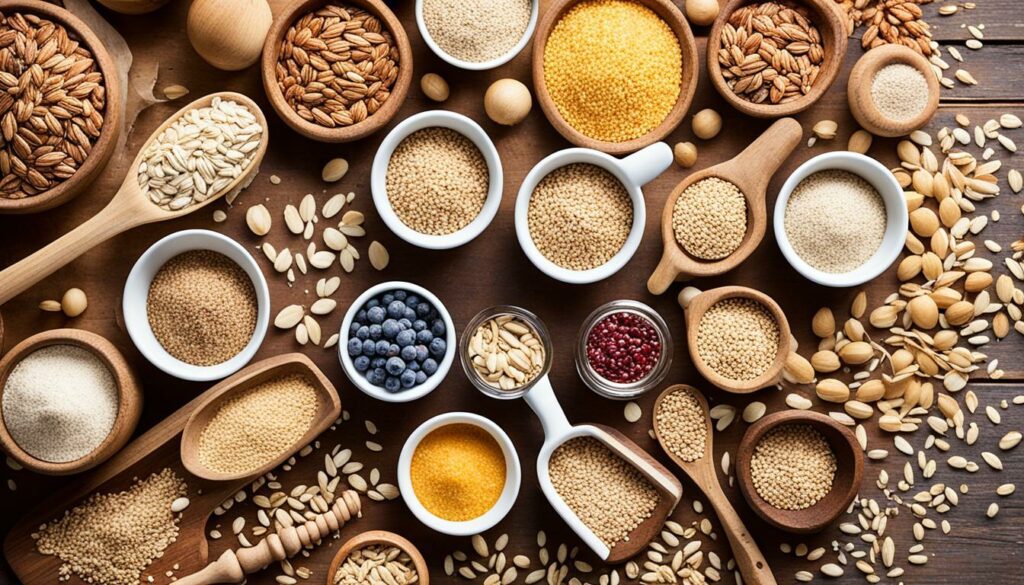
Using whole grain flour like the one from Gianforte Farm means you have to watch the moisture. This type of flour absorbs more water because of the bran and germ. For instance, you might need to add extra liquid when using whole wheat flour to keep the dough soft. Also, don’t be afraid to try different grains, each with its own hydration needs:
It’s also key to get the amount of grain right. You can swap up to half of the regular flour in recipes with whole wheat without changes. But if you use more, you’ll need more moisture.
When baking with whole grains, the protein amount matters a lot. Different grains have different protein levels that affect how the dough rises. Here’s a quick guide:
It’s crucial to manage protein levels, especially with ancient grains. A simple chart can help you do this:
| Grain Type | Hydration Level | Flavour Notes |
|---|---|---|
| Sorghum | Low | Light corn |
| Millet | Low | Bland, sometimes bitter |
| Amaranth | Strong | Earthy |
| Quinoa | Moderate | Corn and legume |
Choosing the right mix of grains can really up your baking game. Start with small changes, maybe 15% of the flour, and then increase as you get the hang of it. Soon, you can be using whole grains for up to half your recipes, like cookies and muffins.
Making whole grain bread at home is truly rewarding. Use fresh, milled flour from places like Gianforte Farm for a farm-to-table experience. Freshly milled flour makes bread tastier and healthier.
When baking whole wheat, you need special recipes. Whole wheat bread might be denser or a bit bitter. But, the right method can fix this, making bread that rises well and tastes great.
For excellent whole grain bread, you’ll need water, whole milk, yeast, wheat flour, honey, butter, lemon juice, and salt. You can also add an oat topping for that personal flair, just before baking the loaf.
Whole wheat baking takes longer but is worth it. The dough needs about 8 minutes of kneading. This helps it become stretchy and soft. Knead well by hand or by using a mixer with a dough hook.
Make sure your bread is fully baked, with an inside temperature of 195–200°F (90–93°C). A sponge method makes the bread tastier and lighter.
Steps for Rolling and Shaping the Dough:
Bake at 350°F (175°C) for about 36–40 minutes. It’s ready when it sounds hollow or hits the right temperature inside. Substituting some of the flour with bread flour might help make a lighter loaf.
These homemade whole grain bread recipes are more than just recipes. They’re about using pure ingredients. Enjoy daily bread that’s truly farm-to-table.
Making the perfect whole grain bread is both enjoyable and challenging. It’s all about the baking steps and watching out for mistakes. I’ll guide you through the key steps to create a scrumptious, hearty loaf. This bread will be everything you hope for.
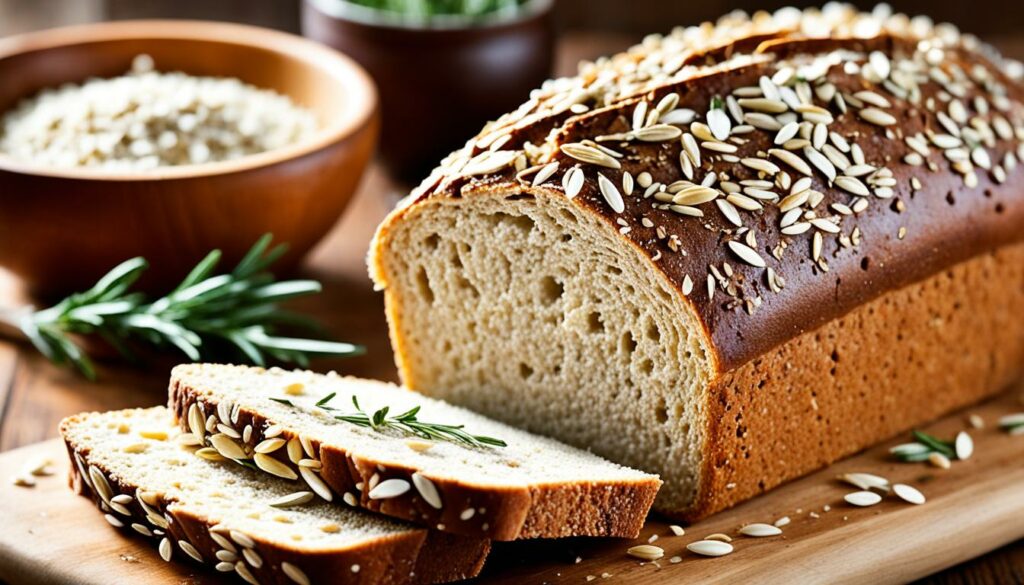
First, get the 8 ingredients you need. You’ll want whole wheat flour (or a mix for a lighter loaf), yeast, brown sugar, salt, butter, and water. Start by making a sponge. This is water, flour, and yeast that should double in size in 60 to 90 minutes. It’s a key step for great taste and texture.
Once your sponge has doubled, add the other ingredients and knead for 8 minutes. Whole grain dough is dense, so this kneading time is crucial for a good gluten structure. After kneading, let the dough rise until it doubles. The time for this will change with the room’s temperature and how humid it is.
Next, shape the risen dough into a loaf and put it in a 9×5 inch pan. Let it rise again until it doubles once more. This second rise makes sure your bread is even and fluffy. Bake at 350°F (175°C) for 36 to 40 minutes. Check with a thermometer; the bread should be 195-200°F (90-93°C) inside.
Choosing the right temperature is crucial to avoid baking mistakes. Dough that’s too warm or cold might not rise well, or it might over-proof. Try to keep the dough at the right temperature by adjusting the water’s temperature.
Another issue is if the crust gets too dark too fast. Covering the loaf with foil halfway through baking can stop this from happening. And don’t forget to check the bread’s internal temperature. This ensures it’s fully baked without being overdone.
By remembering these steps and tips, you’ll become great at baking whole grain bread. Enjoy creating wonderful loaves!
Starting with whole grain pastry baking means looking into their unique benefits. Whole grains aren’t just healthier but also add a unique taste. They give pastries a texture and flavour that’s hard to beat.
In whole grain pastry baking, making the right swaps is key. For instance, you can use white whole wheat flour for half of your regular flour. This adds fibre. Yet, whole grain flours soak up liquid slowly. You may need to add extra liquid. Try adding 2 teaspoons more liquid for each cup of whole wheat flour to keep your mix moist.
For dough that needs yeast, let it rest for 20 to 30 minutes before kneading. This gives the flour time to absorb moisture properly. It makes your baked goods turn out better. To make whole grain breads rise well, add vital wheat gluten or a Whole Grain Bread Improver. Some treats, like moist bars, get better after sitting overnight. This helps to soften the bran and makes them tastier.
Many recipes really highlight the goodness of whole grain pastries. Favorites include Whole Wheat Cinnamon Swirl Bread, Oatmeal Cookies, Whole Wheat Waffles, and Gingerbread. They often suggest lowering fats or sugars to let the whole grain flavours shine. With whole grains, bakers can use various flours. Each, like pumpernickel or quinoa, brings something special to the table.
Interested in learning more? Workshops are available. They explore techniques to make great whole grain pastries. They’re for bakers at any level. These sessions focus on the unique textures, flavours, and baking performance of whole grains. Learning this can make your pastries amazing.
Freshly milled flour from farms like Gianforte is now a top pick for many bakers. It adds a special, full taste to food. Plus, it keeps more of the good nutrients than typical store flours do.
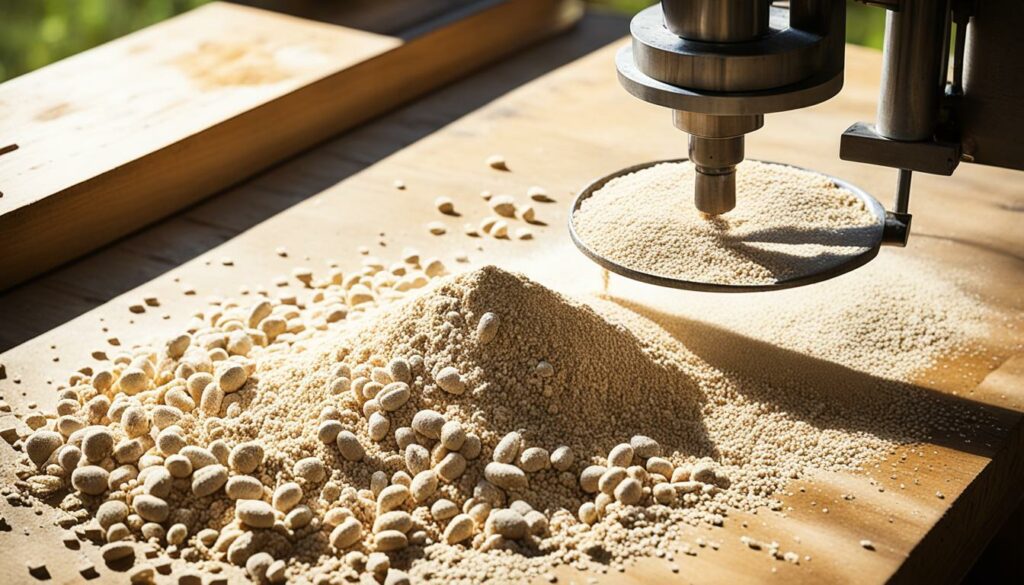
One big plus of using freshly milled flour is its rich nutrition. Traditional flour loses up to 25% of its good stuff soon after milling. Yet, flour freshly milled keeps more vitamins, minerals, and fibre. This makes your food taste artisanal, adding a wonderful touch.
Freshly milled flour stands out for being completely pure. It doesn’t have any of the artificial stuff that store-bought flour often does. Breads made with it are known for their alive, nutty, or earthy taste. This comes from the full nutrition and oils in the wheat grain.
Storing freshly milled flour right helps keep its goodness. If kept at room temperature, use it within three days to benefit from its live nutrients. To store it longer, the freezer keeps its great quality for up to six months.
Using freshly milled flour well is key to great baking. Let it warm up to room temperature before baking. This improves how it works in your recipe. Using it quickly after it’s milled keeps its nutrients and great taste strong.
| Grain Type | Protein Content |
|---|---|
| Einkorn | 18.2% |
| Kamut | 14.7% |
| Spelt | 14.5% |
| Hard White | 11.3% |
| Soft White | 10.6% |
| Hard Red Winter | 13.6% |
| Hard Red Spring | 15.4% |
| Soft Red Winter | 10.3% |
| Durum | 13.6% |
| Sorghum | 11.3% |
| Millet | 11% |
| Rye | 10.3% |
| Oats | 16.8% |
I always marvel at how fermentation transforms whole grain bread. It goes beyond making the dough rise. Fermentation adds a depth of flavour you can’t get elsewhere. Sandor Ellix Katz’s “Wild Fermentation” has opened many eyes. It’s sold over 125 thousand copies. This book shows how important fermentation is in today’s baking world.
Pre-ferments mix art and science. My favourite is a levain made from 100% organic flour. It uses a 1:2:2 ratio and 15% inoculation. This method boosts the bread’s taste and structure a lot. Using special wheat types increases the loaf’s nutritional value and taste. I get my wheat from places like Luhrs Certified Seed and Penner Farms.
Fermentation not only develops gluten but also makes bread taste better. I follow a controlled process, starting with a 45-minute autolyse. Then, I do coil folds to make the dough strong. With 80% hydration and 2% salt, the cold overnight proof is key.
Turkey Red wheat, a historic hard winter wheat in the U.S., is my main choice. Mixing it 60% with 40% Central Milling flour gives great results. The Challenger Bread Pan is perfect for baking. Preheat to 500F (260C) and reduce to 475F (230C) for that artisan touch.
| Grain Source | Type |
|---|---|
| Luhrs Certified Seed, Nebraska | Organic Turkey Red berries (seed) |
| Sunflower Acres, Colorado | Turkey Red berries |
| Pleasant Valley Ranch, Oklahoma | Whole grain flour |
| Penner Farms, Minnesota | Whole grain flour |
Controlling the dough’s temperature and how long it ferments brings whole grain bread to new heights. It’s a skill that keeps growing, fascinating bakers everywhere.
Sprouting grains has become popular since the 20th century’s second half. This method enhances grain nutrition and makes baking products tastier. So, what does it mean to sprout grains and how does it help in baking? Let’s explore this further.
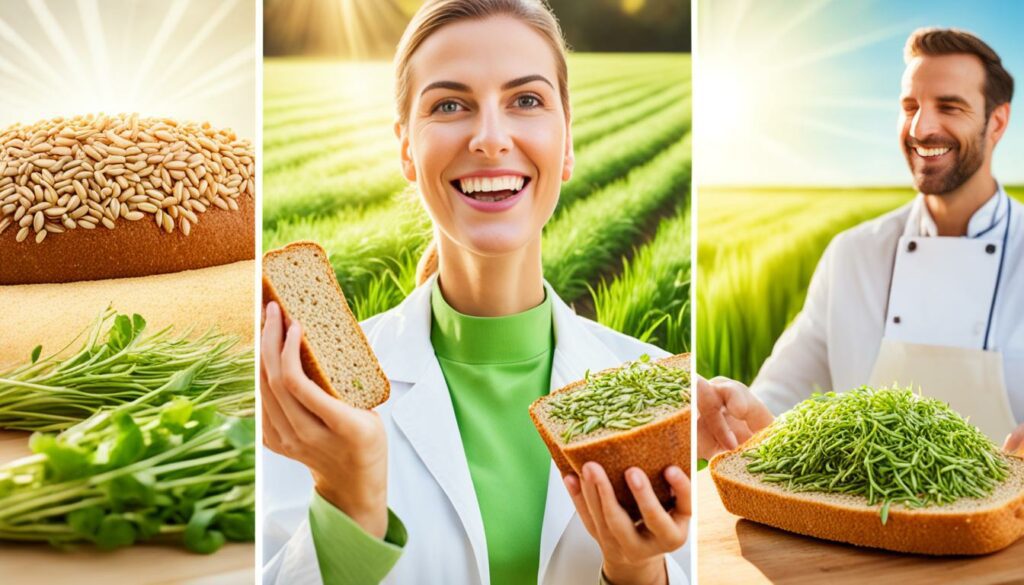
Sprouting grains starts with soaking them in water until they sprout. This process can take 1-3 days. It’s important to keep the right temperature and moisture to prevent rot. After sprouting, you can dehydrate the grains.
Use a food dehydrator overnight at the lowest setting. This makes them good for flour or using in recipes.
Sprouted grains are full of benefits for baking. Firstly, they are more nutritious. Enzymes become active during sprouting, making nutrients easier to digest. This process also lowers the phytate content, which helps you absorb phosphorus better.
Another plus is improved baking properties. Flour from sprouted grains cooks faster than the regular kind. Breads come out with a better structure, staying fresh for longer. They also need less kneading and proofing time. These baked goods are better for those with diabetes, keeping blood sugar stable.
Below is a comparison of different ways to deal with grains and their effects:
| Approach | Dry | Wet |
|---|---|---|
| Processing Method | Sprouting then drying the grains | Mashing sprouted grains into a purée |
| Preparation Time | 1-3 Days (sprouting) + Overnight (dehydrating) | 1-3 Days (sprouting) + Immediate use |
| Benefits | Cook faster | Enhanced texture |
| Final Product | Flour | Purée |
In summary, adding sprouted grains to your baking boosts nutrition and taste. Learning how to sprout grains well enhances baking. It makes it healthier and more satisfying.
Baking with whole grains lets people with specific diets enjoy tasty and healthy treats. It’s great for those who are gluten-free or vegan because whole grains fit many needs. They offer a variety that suits different dietary restrictions.
Gluten-free whole grain options include rice, quinoa, and buckwheat. These grains are not just safe for special diets. They also add interesting flavours and textures.
Rice flour makes cakes and pastries light and soft. Quinoa flour gives bread and muffins a delicious, nutty taste. Using whole grains in flour form adds a lot of nutrients to your baking.
In vegan baking with whole grains, swapping out animal products is key. Flours like spelt, einkorn, and oats add great flavour and nutrition.
Oat flour, for one, boosts the protein and fibre in cookies and bars. It makes them a healthy snack. Sprouted flours make baked goods easier to digest. They also lend a subtle sweetness, perfect for vegan pastries.
Using these flours makes vegan baking more nutritious. They let everyone enjoy the goodness of whole grains.
Whole grain flours from farms like Gianforte offer a range of recipes. Bakers can link their efforts in the kitchen directly to the farm’s fresh produce. Mastering recipes for items like whole grain bread and muffins makes the farm-to-oven journey rewarding and real.
Just picture devouring a slice of crusty, farm-fresh whole grain bread. It’s packed with the richness of whole wheat flour. This farm-fresh whole grain bread recipe has a 4.58-star rating from 142 votes. Let’s find out why:
For this recipe, you’ll need:
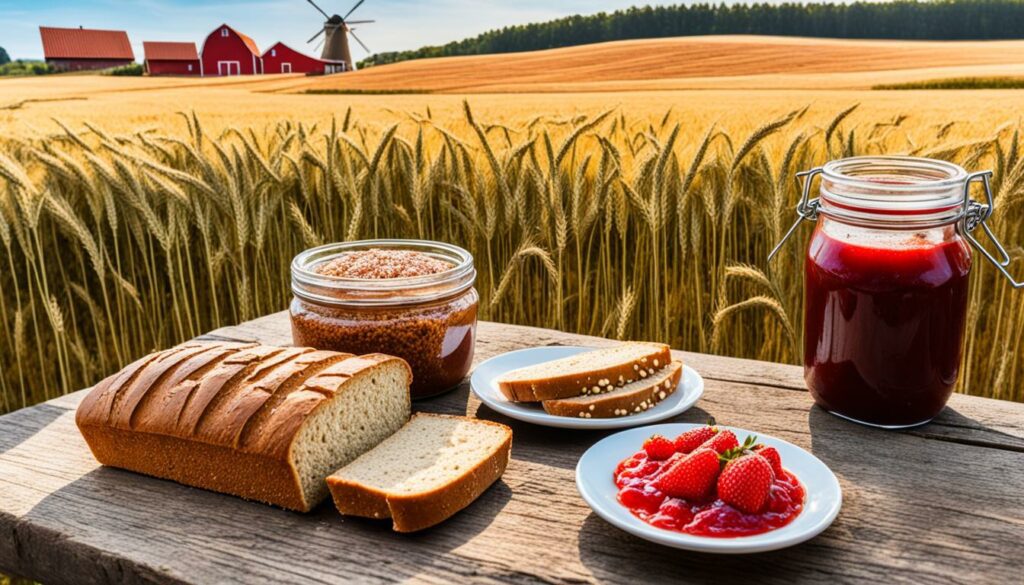
This bread is loved for its crisp crust, not lasting long, and the time it takes to ferment. It tastes best on the day it’s made, but you can store it in the fridge or freezer as well. You don’t need a dutch oven if you have two cake pans or an oven-safe saucepan with a lid. To warm up frozen bread, cut and freeze it, then pop the slices in a toaster until ready.
At Bobolink Dairy and Bakehouse, countless loaves of bread have been made, showing a longstanding bread-making tradition in the U.S. Now, thanks to a renewal in small-scale grain growing, bakers can feel closer to where their grains come from.
Whole grain muffins are a great way to enjoy farm-fresh goodness at home. They’re not just tasty but also full of nutrients, making them a healthy snack or breakfast. Important aspects of these muffins are:
Baking these muffins connects us to the traditional feel of small-scale farms. It pairs well with the work of groups like River Valley Community Grains, who push for sustainable, diverse small grain farming.
Making farm-fresh whole grain bread and muffins celebrates the farm-to-oven experience. It makes my baking more meaningful and helps local farmers who work to preserve ancient grains.
Comparing commercial and farm-fresh flours shows clear differences in taste and nutrients. Commercial flours are stripped of natural bran and germ, losing important vitamins and oils. In contrast, farm-fresh flours keep these parts, so they’re more nutritious.
| Aspect | Commercial Flours | Farm-Fresh Flours |
|---|---|---|
| Nutritional Value | Lower, due to removal of germ and bran | Higher, retains germ and bran |
| Flavour | Often bland | Rich, distinctive, fresh |
| Texture | Consistent but sometimes lacks substance | Full-bodied, varied textures |
| Cost | Generally cheaper | Varies, but can be more expensive |
| Shelf Life | Longer due to lack of oils | Shorter unless properly stored |
Grinding whole grains yourself can save you money in the long run. This method keeps the nutrients in peak condition. Using farm-fresh flours can make cakes and breads taste better and feel lighter.
There are many types of grains to grind. From common ones like Spelt to more exotic options like Kamut, the choices are varied. This variety adds unique flavours and textures to your baking, something hard to find in commercial flours.
Farm-fresh flours do cost more, though. For example, a bag of special flour from Castle Valley in Bucks County, Pennsylvania is $19 for 10 pounds. This equals $1.90 per pound, more than many commercial options. But the quality and taste of the bread you make can be worth it.
To sum up, picking between commercial and farm-fresh flours depends on what matters to you. If health, taste, and local support are key, farm-fresh flours are the way to go.
Through our look into baking with whole grains, we’ve seen many good things. These go beyond just making tasty treats. Most baked goods use refined flour, but we have a big chance to better this. Whole grains are full of important nutrients like B vitamins and antioxidants. They make our diet healthier.
Choosing whole grains improves our food’s nutrition. It also lets us play with new flavours and textures. Different wheat types like red or white, spelt, and ancient grains bring something special to recipes. Dark rye or Pumpernickel flour, for example, has lots of nutrients and brings a unique taste.
Using whole grains helps with digestion and offers health perks. Swapping white flour for whole-grain flour in recipes makes food much healthier. But, baking with these flours needs some know-how, like adjusting for liquid and fermenting. Baking with whole grains isn’t just good for us. It supports the earth and local farmers. It helps us cherish our baking history and enjoy food more fully.
Whole grains offer many health perks. They’re packed with fibre, vitamins, minerals, and other plant nutrients. The bran has fibre, the germ has good oils, and the endosperm has many nutrients. Using these in baking boosts digestive health and helps fight off some illnesses.
By choosing whole grains for baking, you back farming that’s gentle on the planet and local economies. Farmers at places like Gianforte Farm grow crops sustainably, reducing harm to the Earth and building strong local ties. Buying their whole grain flours supports these good practices.
Whole wheat and wholemeal flours are quite alike. They both use the whole grain. This keeps more nutrients and fibre in the flour. The main change might be in the wheat type used. But, they’re mostly the same when it comes to nutrition.
There’s a variety of whole grain flours out there. You’ll find whole wheat, spelt, rye, barley, and oat flours. Each brings a different flavour and texture to your baking. At Gianforte Farm, you can get Bread Flour for strong bread structures and Pastry Flour for finer pastries.
Choosing the right whole grain flour depends on what you’re baking. For bread, pick high-protein flours like Gianforte’s Bread Flour. For pastries, go for Pastry Flour which has less protein. Look at the recipe to decide what’s best for the texture you want.
To start baking with whole grains, you’ll need the basics. A mixer, mixing bowls, and measuring tools are essential. It’s also good to have a baking stone, dough whisk, and thermometers for top-quality results.
Whole grain flours soak up more liquid than refined flours. To get your dough’s moisture right, add liquid slowly. The amount of water needed can vary, so it’s okay to experiment until you get it right.
It’s important to adjust for protein differences in whole grain flours. Flours high in protein, like hard red wheat, work better for bread. Flours with less protein need less water and are good for pastries. Make sure to change the recipe liquid to match the flour protein level for the best outcome.
Sure thing! Check out recipes that use freshly milled flours, like those from Gianforte Farm. Adding pre-ferments helps. For great recipe ideas, look at books like “Whole Grain Baking: Delicious Recipes Using Nutritious Whole Grains” by King Arthur Flour.
For flawless whole grain bread, start with the best flour and measure everything well. Use pre-ferments for flavour and structure. Control the dough temperature throughout. Keep an eye on kneading, proofing, and baking times for a perfect loaf every time.
To get into whole grain pastries, you need to make some tweaks. Use whole grain pastry flour, like from Gianforte Farm. You might need to adjust moisture and fat or sugar levels. Try recipes from muffins to tarts to find new and tasty treats.
Freshly milled flours, like those from Gianforte Farm, taste better and offer more nutrients. The germ’s oils add to the taste. By storing the flour right and letting it warm up to room temperature, you can keep its quality high.
Using pre-ferments boosts the flavour and texture of whole grain bakes. They help gluten develop, which is great for structure. Keeping the dough at the right temperature during mixing makes everything better.
To sprout grains, soak them and rinse daily until they sprout. Sprouting makes them more nutritious and adds a nice, sweet taste. Once sprouted, dry and mill them into flour for recipes.
Definitely. For gluten-free diets, there are options like rice, quinoa, and buckwheat flours. Vegans can swap in plant-based ingredients in recipes. This way, everyone can enjoy the tasty and nutritional perks of whole grain baking.
Try recipes that put fresh, farm-sourced whole grains in the spotlight. You could make bread with high-protein flour or tasty muffins. These dishes show off the farm ingredients and make baking more rewarding.
Farm-fresh flours, like those from Gianforte Farm, outdo commercial flours. They’re more nutrient-packed and tastier. That’s because they keep all the grain bits and are minimally processed. This leads to better texture and flavour in your baking.